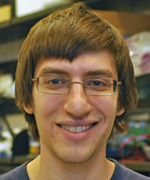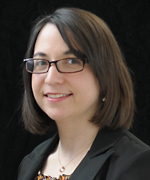NIH’s First Intramural Early Independent Scientists
Interviews with Greg Alushin (NHLBI) and Donna Calu (NIDA)
Greg Alushin (NHLBI) and Donna Calu (NIDA) are the first two intramural scientists to receive the NIH Director’s Early Independence Award. The award—which has been in existence since 2011 and has traditionally been given to extramural investigators—is an opportunity for young scientists, who have recently received their doctoral degree or finished medical residency, to skip the postdoctoral years of training and advance directly into an independent research career. The NIH Common Fund provides each independent scientist with funding up to $250,000 in direct costs per year for five years. The following is a lightly edited version of interviews with Alushin and Calu.
GREG ALUSHIN, PH.D.

Early Independent Scientist
Laboratory of Macromolecular Interactions,
Cell Biology and Physiology Center,
National Heart, Lung, and Blood Institute
Education: B.A. in biochemistry from Columbia University (New York); Ph.D. in biophysics from the University of California, Berkeley (Berkeley, Calif.)
How did you become interested in macromolecular interactions?
Steven Almo at the Albert Einstein College of Medicine in the Bronx introduced me to the idea that most things happening inside of a cell are orchestrated by groups of macromolecules—mostly protein-protein interactions. I found it exciting and fascinating that a relatively limited number of “ingredients” encoded in the genome could provide such diversity in biology.
What was the focus of your previous research before you came to the NIH?
In graduate school I studied the interaction of kinetochore complexes with microtubules. One complex called NDC80 [kinetochore complex] is found in all eukaryotes. Using structural methods, I figured out how it binds microtubules and how that interaction can be regulated.
What is your current research focus at the NIH?
I initially came here to do a postdoc with Clare Waterman. While I was in her lab I became more interested in the actin cytoskeleton. The structural transitions in actin may have a role in responsiveness to forces. We’re trying to understand whether tension introduces a conformational change in actin and then what is the meaning of that for a cell.
Are you collaborating with anyone at the NIH or elsewhere?
I am still collaborating with Clare, my mentor. We are also collaborating with Jim Sellers, trying to introduce tension into actin filaments. My other main collaboration is with Sharon Campbell at the University of North Carolina (Chapel Hill, North Carolina). We are working on the interactions of a particular focal adhesion protein, vinculin.
What made you detour from the traditional postdoc route and apply for the Early Independence Award?
Clare really encouraged me. I think it allowed me to get to my long-term goal to incorporate structural biology and cell biology much more quickly than I would have otherwise.
What advice would you give someone who wishes to follow your path?
You have to have that entrepreneurial spirit. Independent research is a major undertaking, so you have to really know what you want to do. For me it was really important to work out arrangements with different people to get access to equipment and expertise.
What is your next scientific or career goal?
I would like to become a full professor or the equivalent here. Scientifically, my long-term goal is to understand what it is that makes the interactions between proteins so important for organizing a cell in allowing it to be alive. It’s a really big question.
What has been your proudest moment so far in your scientific career?
For me, the discoveries are definitely the most exciting thing. I just had a paper published in Cell based on my work at the end of graduate school with Eva Nogales at the University of California at Berkeley. We ended up figuring out a conformational change that occurs in tubulin when it hydrolyzes [guanosine-5'-triphosphate] inside the microtubule. And getting this [Early Independence] award was a great honor.
What are your interests outside the lab?
Climbing is my main hobby. I started rock climbing, ironically, after I moved away from the West Coast. My fiancée got me into it about a year ago. Now, I climb with a couple of other people from the NIH. It’s a fun challenge.
Note: Alushin was also recently named to the Forbes List of 30 Under 30. You can read the NIH Catalyst article at https://irp.nih.gov/catalyst/v22i3/world-changers.
DONNA CALU, PH.D.

Early Independent Scientist
Neurophysiology of Reward Seeking Section,
Behavioral Neuroscience Research Branch,
National Institute on Drug Abuse (Baltimore)
Education: B.S. in neurobiology and physiology from University of Maryland (College Park, Md.); Ph.D. in neuroscience from the University of Maryland School of Medicine (Baltimore)
How did you become interested in behavioral neuroscience?
My passion for understanding the brain mechanisms underlying associative learning likely stems from my experience as a young adult working with children both with and without learning disabilities. Observing how these children learn about their environments led me to ask questions about how the brain encodes and supports learned behaviors.
What was the focus of your research before you came to the NIH?
During graduate school I became fascinated by the way in which the brain controls behavior. Using predictions derived from classic learning theories, I sought to understand how brain activity could mediate simple associative-learning processes.
What made you detour from the traditional postdoc route and apply for the Early Independence Award?
As a graduate student and postdoc I was given the freedom to explore my research interests with a considerable amount of independence. My mentors, by giving me this flexibility so early in my career, have facilitated this unique opportunity for me to pursue the route of early independence. I am tremendously thankful for their ongoing support.
What made you decide to come to the NIH?
I was drawn to the opportunity to address my research questions alongside the leaders in the addiction field, using groundbreaking techniques such as in vivo electrophysiology and optogenetics. The resources coupled with NIDA’s highly collaborative environment have made it a fantastic place to enhance my training while starting a lab.
What is your current research focus at the NIH?
The aim of our research is to identify the neural correlates and brain mechanisms underlying individual differences in reward learning and motivation. The goal is to understand how these processes may be involved in or predictive of addiction-related behaviors. We combine modern techniques including in vivo electrophysiology, optogenetics, and molecular and transgenic methods with classic behavioral procedures in order to examine in real time the contribution of brain reward circuitry in driving learning and motivational processes.
Ultimately, we seek to understand how individual differences in learning-associated neural correlates (evident prior to drug exposure) may predict drug-seeking behavior and to determine how drugs of abuse influence these brain mechanisms to shape addiction-related behaviors.
What is most exciting about your work?
By combining in vivo electrophysiology with optogenetics, we can first identify brain signals that correlate with observed behavior. Then, by silencing endogenous neural activity and observing changes in behavior, we can directly test the role those signals play in learning. It’s exciting to watch neurons in the brain fire in real time as rats experience surprising rewards. I also enjoy analyzing the neural data to understand how the brain encodes meaningful environmental events.
What has been your proudest moment so far in your scientific career?
The moment I finished presenting my public thesis defense. Looking out and seeing my family, friends, and colleagues there to share that moment with me, I was overwhelmed with feelings of accomplishment and gratitude. That moment will be hard to top.
What is your advice to other young scientists?
Be patient and savor the little victories along the way.
What is your next scientific or career or goal?
I very much enjoy the line of research we are currently pursuing in my lab, and I plan to continue to follow the data in order to examine emerging questions.
What are your interests outside the lab?
I love spending time with my children and my family, listening to music, dancing, and enjoying the outdoors.
For general information about the NIH Director’s Early Independence Award, go to https://commonfund.nih.gov/earlyindependence. For details on how intramural scientists can apply, contact Charles Dearolf (dearolfc@mail.nih.gov or 301-402-1225).
This page was last updated on Wednesday, April 27, 2022
